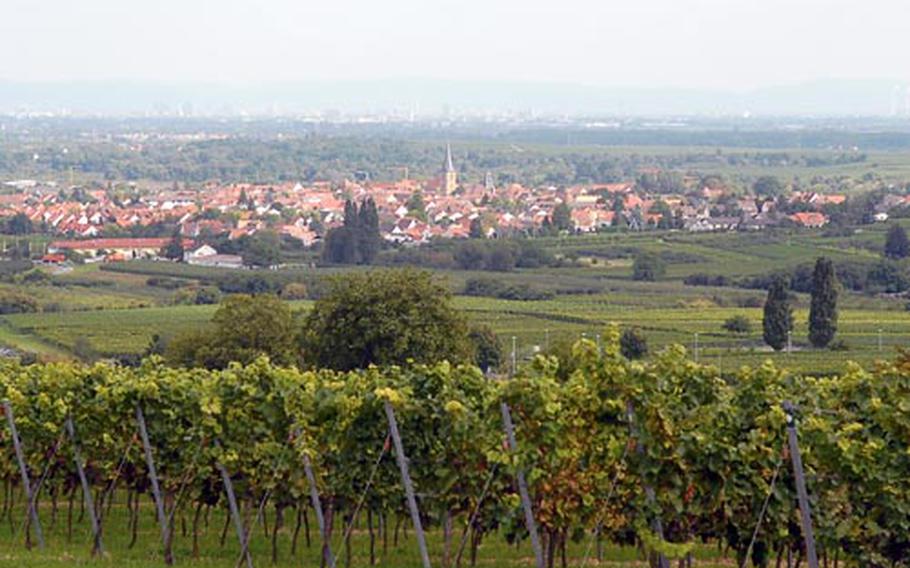
A view over the vineyards toward Freinsheim, and Mannheim far in the distance, can be seen from the Schlosspark in Herxheim. (Michael Abrams / S&S)
It is grape harvest time in Germany, a perfect time to visit the vineyards along the Deutsche Weinstrasse.
The German Wine Road stretches from Bockenheim in the north to the French border in the south, passing through towns and vineyards along the way. This time of year, from September to mid-October, is the season for Neuer Wein, a young wine served before the fermentation process is finished. Signs along the road will announce wineries selling this seasonal specialty — and a sip or two will make visiting the area even more pleasant.
On a recent jaunt through the vineyards, we visited the north, between Bockenheim and Freinsheim.
The Haus der Deutschen Weinstrasse, a building that spans the road in Bockenheim, marks the northern end of the Weinstrasse. The town is full of wineries. The Weinstube zum Kuhstall, a main street wine tavern, open on weekends, is housed in a former cowshed.
The town of Neuleiningen can’t be missed. Its castle ruins can be seen from Autobahn 6 and from the Weinstrasse. Don’t let the neu (new) in its name fool you. The castle and town date to the 13th century. It is just newer than nearby Altleiningen.
Neuleiningen has three parallel cobblestone streets running through it, connected by narrow staircases. They are lined with half-timbered houses, many decorated with flower boxes. A lion tops the fountain on its tiny market square.
Neuleiningen castle is one stop on the 3-Burgen-Wanderweg, a hiking trail that connects the castle with two others, Battenberg and Altleiningen.
While the former is in ruins, the latter is now a youth hostel. High on a hill overlooking Altleiningen and the countryside, it was once the seat of the counts of Leiningen. The outdoor swimming pool at the foot of the castle grounds probably is the only one that can claim a castle as a backdrop.
The Eckbach is a small stream that flows down from the hills of the Pfälzer Wald. Over the centuries it has powered many mills on its way to the Rhine River. Kleinkarlbach, one village along the stream, had six mills. Today, water still flows along the main street of the little wine-producing village’s main street. Bridges, bedecked with flower boxes, connect the street to its houses.
Großkarlbach also has six mills. One of them, the Dorfmühle, soon will house a mill museum when construction is completed. The town has its share of taverns and restaurants, and two of them — Karlbacher, and especially Gebrüder Meurer — are known for fine dining.
Heading south from here, you come to Freinsheim, one of the first tourist magnets on the Weinstrasse. Up a nearby hill is Herxheim am Berg. From the Schlossgarten, there is a panoramic view of the vineyards, with Freinsheim in the distance, and farther away, Mannheim with the hills of Odenwald beyond.
An interesting thing about Herxheim is that it has a palace park, but no longer a palace.
Higher up the hillside is Weisenheim am Berg. Not much to see here, but the town is known for its wineries and taverns. One of these, the Admiral, features fine dining.
From here the Weinstrasse heads south toward Kallstadt and on to Bad Dürkheim, one of the capitals of the German Wine Road.
But that is another story.
Know & goDirections: The northern area of the Deutsche Weinstrasse is between Kaiserslautern and Mannheim, off Autobahn 6. Exit the autobahn at Wattenheim if you want to visit Altleiningen first; otherwise exit at Grünstadt and follow signs.
Times: Now is the time to visit the Weinstrasse. Not only is the grape harvest under way, but so is the harvest for apples, pears and potatoes. Farmers sell produce on the roads in front of their farms. Many towns hold Christmas markets in the winter, and in spring there is an explosion of color when the fruit and almond trees bloom.
Costs: Bring euros for food, drink and shopping, but otherwise the trip is free.
Food: Most villages have a tavern or two for a bite to eat, but during the week many will be open only from 11:30 a.m. to 1:30 p.m. and then in the evenings from 5:30 on. On the weekends, most will serve all day. Try specialties of the Palatinate, which on menus will have the prefix Pfälzer: Saumagen, Bratwurst and Leberknödel (liver dumpling), and in the fall try Zwiebelkuchen (onion cake) and Neuer Wein.
Web: There are German-only Web sites on the area at www.deutsche-weinstrasse.de, www.neuleiningen.de and www.altleiningen.de. Go to legacy.stripes.com for a visit to Freinsheim and biking along the Weinstrasse.